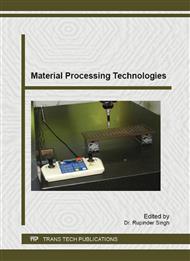[1]
H. Ahuett, R. Garza, A. Miller. The effect of heat released during fill on the deflection of die casting. Journal of Materials Processing Technology. 142, 648- 658, (2003).
DOI: 10.1016/s0924-0136(03)00685-x
Google Scholar
[2]
H. T Domkin. Investigates soldering of cast alloys to the dies continuing source of die surface damage in the aluminium die casting. Journal of Material Processing Technology. 209, 4051-4061, (2008).
Google Scholar
[3]
L. Cerri, and Marco. Hot compression behavior of the AZ91 magnesium alloy produced by high pressure die casting. Journal of materials processing technology. 189, 97–106, (2008).
DOI: 10.1016/j.jmatprotec.2007.01.010
Google Scholar
[4]
R. Singh and H. Singh. Effect of some parameters on properties of hot chamber die casting. Lambert Academic Publishing AG & Co. KG, Saarbrücken, Germany, ISBN 978-3-659-13087-8, (2012).
Google Scholar
[5]
S. Matthew, A. Dargusch, G. Dourb, C. Schauer, C.M. Dinnis and G. Savaged. The influence of pressure during solidification of high pressure die cast aluminium telecommunication components. Journal of Materials Processing Technology. 180, 37- 43, (2006).
DOI: 10.1016/j.jmatprotec.2006.05.001
Google Scholar
[6]
Yoshihiko and Soichiro. Quantitative evaluation of porosity in aluminium alloy dies castings by fractal analysis of spatial distribution of area. Material and design. 30, 1169-1173, (2009).
DOI: 10.1016/j.matdes.2008.06.025
Google Scholar
[7]
Zhi-Peng, Xiong, M. Cheng, and Allison. Determination of the heat transfer coefficient at metal-die interface of high pressure die casting process of AM50 alloy. International journal of heat and mass transfer. 51, 6032-6038, (2008).
DOI: 10.1016/j.ijheatmasstransfer.2008.04.029
Google Scholar
[8]
R. Singh and R. Kapoor. Effect of pressure on casting properties in cold chamber die casting", Lambert Academic Publishing AG & Co. KG, Saarbrücken, Germany, ISBN978-3-659-12721-2, (2012).
Google Scholar
[9]
R. Singh. Modeling of surface hardness in hot chamber die casting using Buckingham's π approach. Journal of Mechanical Science and Technology. 28 (2), 699-704, (2014).
DOI: 10.1007/s12206-013-1133-4
Google Scholar
[10]
R. Singh and H. Singh. Effect of Some Parameters on the Cast Component Properties in Hot Chamber Die Casting. Journal of Institution of Engineers India Ser. C. DOI 10. 1007/s40032-015-0213-x- In-press.
DOI: 10.1007/s40032-015-0213-x
Google Scholar


